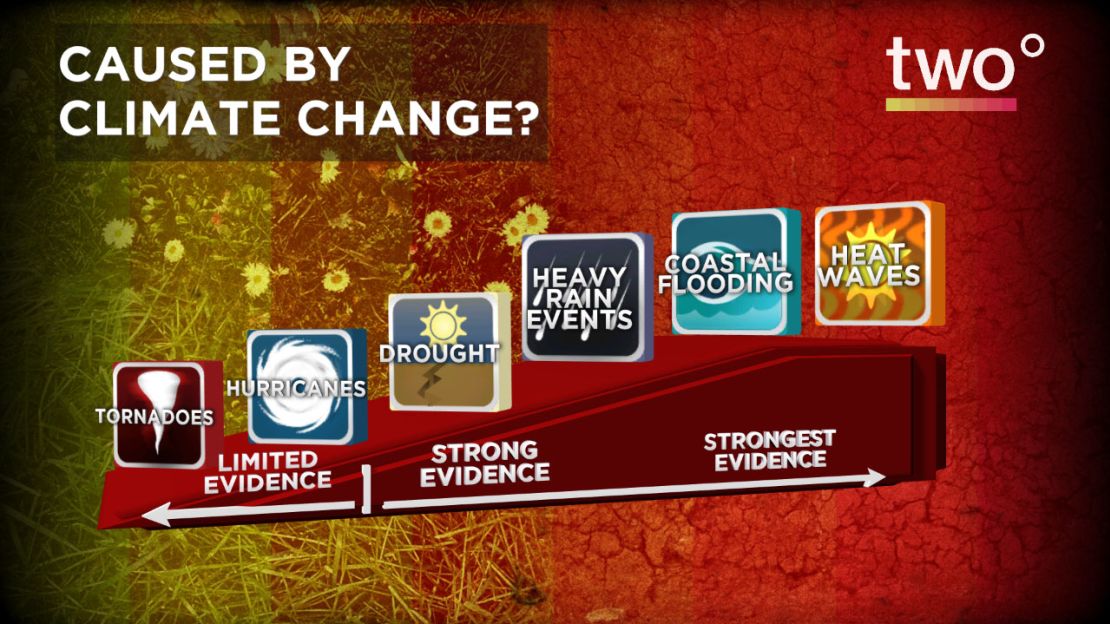Editor’s Note: On Fridays, CNN answers one of our audience’s climate change questions as part of the Two Degrees series. Ask your question by filling out this online form. And sign up for the Two Degrees newsletter to learn more.
The most common question I receive as an international news meteorologist is this: “Was [insert major weather disaster here] caused by climate change?”
One of these questions recently came my way from Sital Sathia, who has been following CNN’s Two Degrees series on climate change from Chicago. Sathia, who is an environmental policy student, phrased the question this way: “Is climate change associated with the treacherous natural disasters we are currently experiencing?”
Attributing extreme weather events to climate change is one of the most important aspects of climate change research. It’s also controversial.
The reason for the latter: It’s difficult to prove a single weather event was “caused” by humans burning fossil fuels and warming the planet. After all, extreme weather has occurred all over our planet long before humans started interfering with the climate system. But scientists are clear that some extreme weather events are influenced by global warming.
How do we decide what’s normal and what’s not?
Let’s look at the recent example of historic flooding in the Southeast, particularly South Carolina and North Carolina.
The record rains are blamed for the deaths of at least 19 people and hundreds of thousands were put under a “boil-water advisory” because of the contamination of water supplies. Was this flooding caused by climate change? We don’t know for sure, at least not yet. More research is needed. But we know this event has the fingerprints of climate change all over it.
This flooding contained a combination of several extreme weather events that we expect to occur more frequently as a result of global warming – including extreme precipitation (i.e. a lot of rain falling in a short amount of time) and coastal flooding.
The South Carolina governor called the event a “one-in-1000 year flood,” which means that the likelihood of this type of event occurring in a given year is about 0.1%. But according to the Intergovernmental Panel on Climate Change, these return periods are decreasing, and the more we warm the planet, the more likely these events are to occur.
This is because the more the planet warms, the more water vapor the atmosphere can hold, adding more rain to big storms. Therefore, this 1-in-1000-year event may become more like a 1-in-100 year event. Indeed, we have seen numerous high-profile examples of these extreme rainfall events recently, including those in France, Japan and Boulder, Colorado.
The flooding in South Carolina was worsened by coastal inundation, particularly in Charleston, where a combination of strong winds, partly associated with nearby Hurricane Joaquin, and high tides caused ocean water to flood much of the city.
Once again, there is a clear climate change connection to this flooding, as sea levels in Charleston have risen a foot in the past century, according to NOAA, which clearly added to the destruction this storm system was able to bring. This gives us a clear example of how coastal cities are being affected by climate change, especially during extreme storms such as those we saw in New Jersey with Superstorm Sandy.
The IPCC produced a special report specifically on the role climate change plays in extreme events.
“Extremes have changed as a result of anthropogenic influences,” the panel says, “including increases in atmospheric concentrations of greenhouse gases.” But the level of confidence varies depending on the type of event or weather.

This has to do with the rarity of the event (the rarer the event, the harder it is to attribute it to global warming because the historical dataset is very limited), and the complexity of the dynamics required to produce the event.
Heavy rain events and coastal flooding are among the easiest to link to climate change. Heat waves and droughts are somewhat easy to link, but are more difficult.
One recent study looked into the role climate change is playing the California drought and found that, while natural variability is the largest factor in the current drought, “[manmade] warming has substantially increased the overall likelihood of extreme California droughts.” They pin the actual percentage as up to 27% of the three-year drought being caused by climate change.
As science advances, this type of climate detective work may get easier still.
Ask a question and shape CNN’s coverage








































